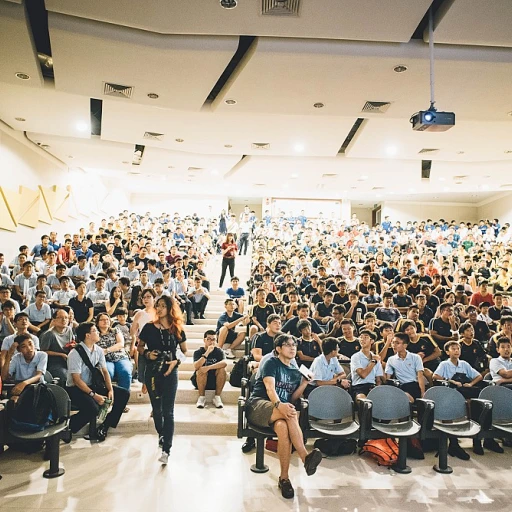The Emergence of the Chief Impact Officer
The Rise of the New Role
In recent years, the rise of the Chief Impact Officer (CIO) role has gained significant traction across diverse sectors. This position isn't just a fleeting trend; it represents a profound shift in how companies perceive their influence on the world. As businesses increasingly prioritize social and environmental impact alongside financial performance, the CIO has become essential in crafting strategies that align corporate objectives with broader societal goals. The need for a Chief Impact Officer is especially apparent in today's fast-evolving job market. More and more organizations are acknowledging that embedding social responsibility into their core operations is not only beneficial for the community but also instrumental in building a sustainable work environment. This role demands a robust blend of leadership, management, and strategic skills, ensuring that the company's mission resonates with both employees and the community at large. As the architect of a company's impact strategy, the CIO works closely with senior management, including the chief executive officer and vice president, to foster a culture that emphasizes long-term value creation. By integrating social impact initiatives with company policies and work environment improvements, the CIO sets the stage for a vibrant and engaged workforce. Exploring careers in this field suggests an increasing demand for professionals who can navigate the nuances of social impact, employee engagement, and leadership. As organizations continue to evolve, the strategic functions of the Chief Impact Officer will likely expand, further solidifying their critical presence in shaping the future of work.Key Responsibilities and Skills
The Expanding Expertise Required for Leadership
The role of a Chief Impact Officer (CIO) in HR tech demands a unique blend of responsibilities and skills. This position isn't just about implementing technology; it's about driving social and organizational impact through strategic leadership. Key Responsibilities:- Strategic Development: CIOs are tasked with developing a comprehensive impact strategy that aligns with the company's goals. This involves collaborating with management teams and serving as a bridge between directors, vice presidents, and the workforce.
- Policy Implementation: They lead the creation and enforcement of policies that ensure the organization's social and environmental values are upheld.
- Program Oversight: Overseeing programs that foster community engagement, employee engagement, and mental health initiatives ensures the company remains socially responsible.
- Technology Integration: Integrating advanced HR technology solutions that facilitate effective long-term impact measurements, CIOs enhance the organization's ability to work efficiently within a shared services model.
- Leadership and Vision: A CIO needs strong leadership qualities, with the ability to inspire and drive change throughout the company.
- Social Media Savvy: Given the impact of social media on organizational culture, CIOs must be adept at leveraging these platforms to enhance the company's reach and reputation.
- Analytical Skills: The ability to analyze data and measure impact is crucial for success in this role. They must assess and report the effectiveness of social impact initiatives.
- Communication: Effective communication skills are essential for conveying the organization’s impact strategy and gaining buy-in from all stakeholders.
Impact on Organizational Culture
Transforming the Company Culture
The role of a Chief Impact Officer (CIO) particularly shines in the domain of organizational culture. This role is pivotal in inspiring a culture that embraces social impact as a key component of business strategy. The Chief Impact Officer works closely with the chief executive and other leaders, formulating policies that inherently value community benefits alongside corporate success. A well-integrated CIO can enhance employee engagement by designing programs that align corporate work with meaningful social and environmental goals. Such alignment doesn't merely benefit the society; it fosters a more cohesive and motivated team within the organization. When employees find purpose in their work beyond mere job descriptions, it contributes significantly to job satisfaction and mental health. Furthermore, the position of a CIO leverages tools like shared services and social media to disseminate social values across the organization. These tools are crucial to reinforce the mission and encourage every team member to participate actively in the company's social programs, which, in return, improves the overall company environment. Studies show that companies with a robust social impact strategy are perceived favorably by both employees and customers alike, resulting in long-term benefits. For organizations based in dynamic and forward-thinking locales like San Francisco, this becomes even more crucial as the competition for top talent intensifies. The ability to work within a socially responsible framework not only enhances organizational reputation but also attracts individuals who prioritize meaningful work environments. Overall, the Chief Impact Officer's role must crescendo towards making social impact a shared mission within the company framework. By steering the organization towards a more coordinated social impact approach, the CIO not only molds a new era of impactful leadership but also cultivates a thriving work environment. For more insights on understanding employee rights in HR investigations, check out our blog post on HR investigations.Integrating Technology and Social Impact
Bridging Technology with Social Impact
The role of a Chief Impact Officer (CIO) in HR tech is pivotal in integrating technology with social impact initiatives. This position requires a strategic approach to leverage technology in a way that aligns with the organization's social and environmental goals. The CIO collaborates with the technology team to develop programs that not only enhance operational efficiency but also contribute positively to the community and work environment.
By adopting advanced HR tech solutions, the CIO can streamline processes, improve employee engagement, and foster a culture of inclusivity. These technologies enable the organization to address mental health issues, promote shared services, and enhance the overall employee experience. The integration of technology and social impact is not just about efficiency; it's about creating a sustainable and supportive work environment.
Crafting Policies for Long-Term Impact
The Chief Impact Officer plays a crucial role in policy development, ensuring that technology-driven initiatives align with the company's long-term social and environmental strategies. This involves working closely with the executive team, including the Chief Executive Officer and Vice President, to develop policies that reflect the organization's commitment to social responsibility.
Effective policy management requires a deep understanding of the organization's goals and the ability to translate them into actionable strategies. The CIO must ensure that these policies are not only compliant with the organization's user agreement and privacy policy but also resonate with the company's mission and values. This alignment is essential for fostering a positive organizational culture and driving sustainable impact.
Leadership in a Dynamic Environment
Leadership is a critical component of the Chief Impact Officer's role. This position demands the ability to lead cross-functional teams and manage complex projects that span various aspects of the organization. The CIO must exhibit strong leadership skills to inspire and motivate the team, driving initiatives that align with the organization's social impact goals.
In the ever-evolving landscape of HR tech, the CIO must stay ahead of trends and challenges. This involves continuous learning and adaptation to new technologies and methodologies. By fostering a culture of innovation and collaboration, the CIO can ensure that the organization remains at the forefront of social impact initiatives.
Measuring Success and Impact
Evaluating the Chief Impact Officer's Success
In the dynamic world of human resources, the role of the Chief Impact Officer (CIO) is crucial for driving meaningful change within an organization. Measuring the success and impact of this position involves a multifaceted approach that aligns with both organizational goals and social impact initiatives.
Key Metrics for Assessing Impact
To effectively gauge the CIO's contributions, companies often rely on a combination of quantitative and qualitative metrics. These metrics are designed to reflect the officer's influence on both the internal work environment and the broader community.
- Employee Engagement: Monitoring employee engagement levels can offer insights into the CIO's effectiveness in fostering a positive work environment and enhancing mental health initiatives.
- Social Impact Programs: The success of social and environmental programs initiated by the CIO can be measured through their reach and sustainability. This includes assessing the long-term benefits to the community and the organization.
- Organizational Culture: Evaluating changes in organizational culture and team dynamics can indicate the CIO's influence on leadership and management strategies.
- Policy Implementation: The successful integration of policies related to social impact, privacy, and user agreements can be a testament to the CIO's role in aligning company strategies with ethical standards.
Challenges in Measuring Impact
While the role of the Chief Impact Officer is pivotal, measuring their success is not without challenges. One major hurdle is quantifying the intangible benefits of social impact initiatives. Additionally, aligning the CIO's goals with the company's strategic objectives requires continuous collaboration and adaptation.
To overcome these challenges, organizations may employ a combination of data analytics and feedback mechanisms. This approach ensures that the impact officer's contributions are visible and aligned with the company's mission and values.
Looking Ahead
As the role of the Chief Impact Officer evolves, companies will need to adapt their evaluation strategies to keep pace with changing expectations. By focusing on both immediate outcomes and long-term impacts, organizations can ensure that their CIOs continue to drive meaningful change and foster a culture of social responsibility.
Future Trends and Challenges
Anticipating the Future of the Chief Impact Officer Role
As organizations continue to embrace the evolving landscape of human resources technology, the role of the Chief Impact Officer (CIO) is set to undergo significant transformations. These changes will be driven by several key trends and challenges that are expected to shape the future of this pivotal position.
Embracing Technological Advancements
With the rapid advancement of technology, CIOs will need to leverage cutting-edge tools to enhance their impact. This includes utilizing data analytics to inform strategy and decision-making processes, as well as adopting AI-driven solutions to streamline operations. The ability to integrate technology with social impact initiatives will be crucial for CIOs to remain effective in their roles.
Fostering a Culture of Innovation
As organizations strive to create more inclusive and innovative work environments, CIOs will play a vital role in fostering a culture that encourages creativity and collaboration. This involves implementing policies and programs that support mental health and employee engagement, ensuring that the workforce is motivated and productive.
Navigating Regulatory and Policy Challenges
The increasing focus on social and environmental responsibility will require CIOs to stay abreast of regulatory changes and compliance requirements. Understanding the nuances of privacy policy and user agreement regulations will be essential for maintaining trust and transparency within the organization.
Building Stronger Community Connections
As the role of the CIO continues to evolve, there will be a greater emphasis on building and nurturing relationships with the community. This involves collaborating with external stakeholders and aligning the organization's social impact goals with broader societal needs. By doing so, CIOs can enhance the company's reputation and contribute to long-term sustainability.
Preparing for Leadership Challenges
Finally, the future of the CIO role will demand strong leadership and management skills. As organizations become more complex, CIOs will need to work closely with other executives, such as the Chief Executive Officer and Vice President, to ensure alignment of the company's mission and vision. This will require a strategic approach to leadership, with a focus on driving positive change and achieving impactful results.








